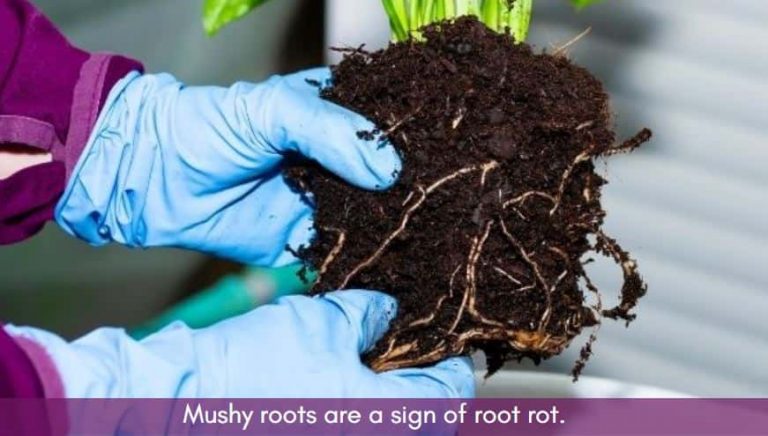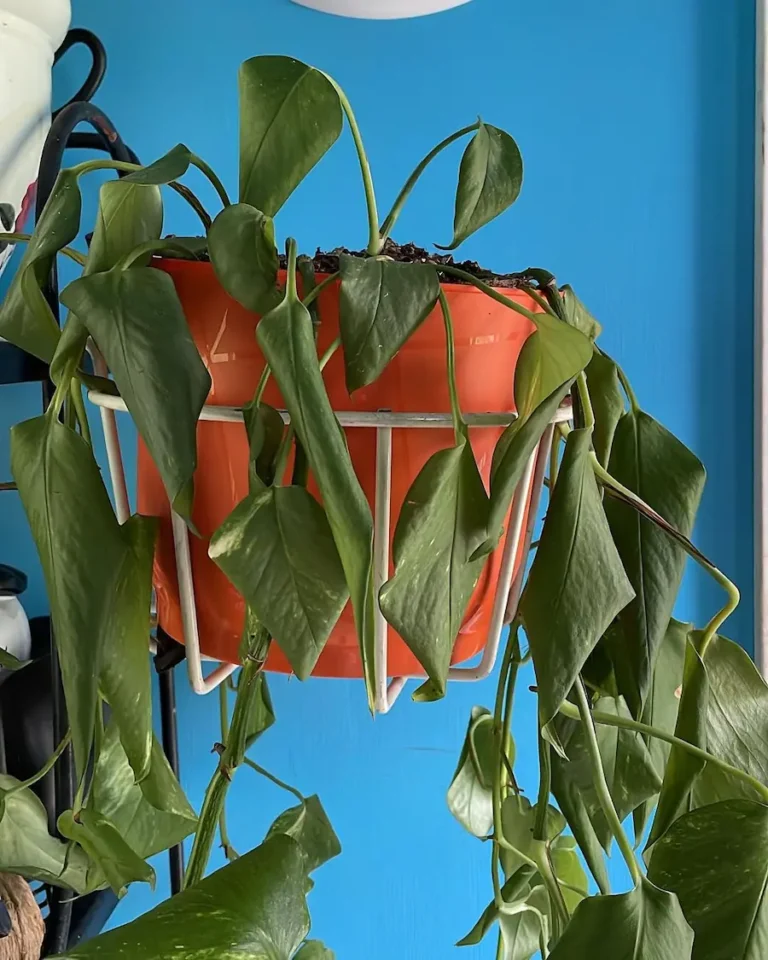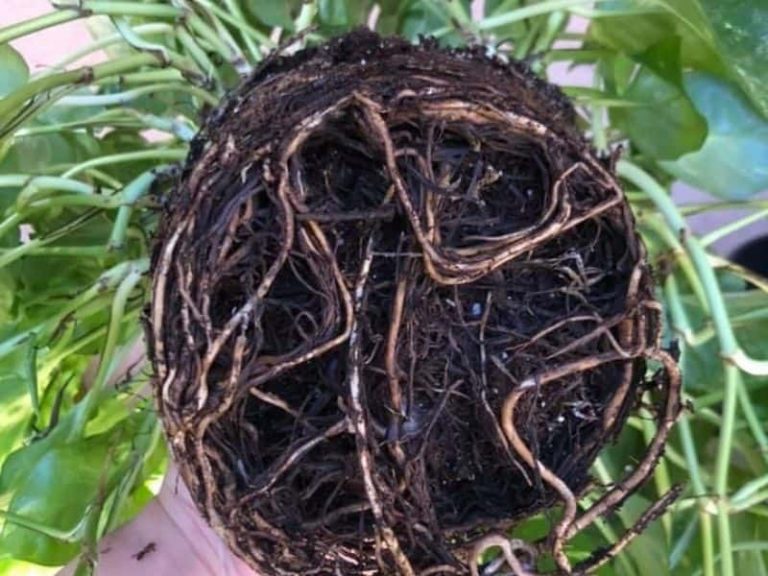Why Pothos Leaves Are Turning Yellow + Fixes that WORK

The leaves of healthy pothos (Epipremnum aureum) should appear vibrant and glossy. When there’s discoloration, your plant is telling you something is wrong.
Why are the leaves of your pothos turning yellow?
The reasons for yellow leaves in pothos include overexposure to sunlight, overwatering, extreme heat, fertilizer burn, and nutrient deficiency. Repotting the plant in a fresh, well-drained soil mix, placing it in bright indirect light, and watering it every 1-2 weeks will resolve the problem.
Cut off old, yellowing foliage to allow new leaves to emerge and make the plant beautiful again.
Causes and Fixes for Yellow Leaves in Pothos
Here are 6 reasons why your pothos leaves are turning yellow:
| Reason for yellowing | Best fix |
| Overwatering | Repot in a fresh soil mix. |
| Overexposure to sunlight | Move pothos to a spot with bright indirect light. |
| Chemical burn | Drain excess fertilizer from the pot. |
| Root rot | Treat with weak hydrogen peroxide solution; repot. |
| Old leaves | Prune the old yellow foliage. |
| Underwatering | Water every 1-2 weeks to keep the soil moist. |
1. Overwatering
Overwatering leaves the plant in soggy conditions leading to the suffocation of roots. Limited oxygen supply means the plant cannot feed and breathe properly.
With the roots gradually dying out, the rest of the plant is deprived of crucial nutrients needed for growth. As such, the pothos leaves start turning yellow, with some even falling off.
When overwatered, pothos leaves will turn yellow, wilt, and appear unhealthy. In severe cases, leaves will develop brown spots.
Best fix
The best way to save yellowing pothos from overwatering is to repot the plant in a fresh, well-drained soil mix. Here’s how to do it:
- Remove the pothos from its pot.
- Pour away the old potting mix that’s soggy.
- Cut off any rotting roots and old yellow leaves.
- Fill the plant’s container with a new well-drained potting mix.
- Replant your pothos and place it near an east-facing window for bright indirect light.
- Water the plant once every 1-2 weeks.
The rule of thumb is to wait for the soil to dry out between waterings.
Alternativey, you can drain the soil to help revive the plant.
Move the pothos to a shaded area and gently remove it from the pot. Place the root ball on top of a layer of newspapers to drain the excess water from the roots. Spread the oversaturated soil on a dry surface and leave it to lose excess moisture then use it to repot the plant afterward.
2. Root rot disease
Root rot is a fungal disease that occurs when the plant is left in excess moisture (usually caused by overwatering). Common types of plant fungal diseases are pythium root rot and bacterial root rot.
- Pythium root rot: Mature leaves of the pothos plant turn yellow and fall off unusually. Roots also turn black and develop a mushy texture.
- Bacterial leaf spot: The undersides of the leaves show water spots with yellow halos.
How to fix yellowing pothos due to root rot
- Dispose of the soil in the pot.
- Wash the pot using a bleach solution or weak hydrogen peroxide.
- Trim off the infected roots and dip the remaining ones in a fungicide.
- Repot the pothos in a fresh potting mix that’s not expired.
Pro tip: On a yellowing pothos plant, unhealthy roots affected with root rot appear black and feel mushy. They can even fall off when touched. These are the roots you want to cut off to prevent the spread of the disease.
These fungi deprive your plants of essential nutrients, leading to root rot and leaf drooping in pothos.
3. Fertilizer burn
If you’re trying to make your pothos grow fuller fast, you may have applied too much fertilizer and ended up with yellow and brown leaves on the plant.
The excess salts in the fertilizer pull moisture away from the roots of your indoor plants through reverse osmosis, and the signs start to show in the leaves and roots. Stunted growth, wilting, and browning leaves are the first signs of overfertilization.
The application of fertilizer too frequently leads to chemical build-up in the soil. This is common if you are using a small planter that’s root-bound.
Best fix
Drain the excess fertilizer from the pot to save your pothos and stop the yellowing. Pour plenty of distilled water into the pot and fill it to the top edge. Allow all the water to drain out. Repeat this procedure up to 4 times to wash away all the excess fertilizer from the container.
A good fertilizer schedule for pothos is once every two or three months.
4. Underwatering
Insufficient water makes your pothos adjust by conserving nutrients and energy. The resultant effect is the yellowing and dying of leaves, starting with those at the base.
Other signs of underwatering in pothos include curling leaves (in an attempt to conserve water), wilting, and drooping.
Best fix: Push your index finger into the soil. If it comes up dry, give the plant some water until it starts to drip from the drainage holes. Keep the soil moist by watering every 1-2 weeks.
5. Overexposure to direct sunlight
Pothos plants like various light conditions ranging from low to moderate light when growing indoors. Outdoors, the plant will thrive well in partial shade, usually under trees.
Overexposure to direct sunlight can cause pothos plants to lose moisture excessively, leading to unwanted symptoms such as leaves turning yellow, brown spots, wilting, and even dying.
How to fix:
Move your pothos plant to a spot where it will receive medium to bright indirect light. I recommend an east-facing window in your house. You can also place it under taller garden plants to protect it from direct sunlight and prevent its leaves from turning yellow.

6. Old leaves
It is normal for older leaves near the base of the stems of your pothos yellowing and falling off. This occurs naturally to create room for the growth of new foliage.
Old leaves contain waste compounds that the plant does not need anymore. The leaves grow old, turn yellow, and fall off the plant as new ones emerge.
Best solution: Leave the old foliage to drop on its own, but if they affect the aesthetics of the plant, cut them off.
Prevention tips
To keep your pothos healthy and prevent the yellowing of leaves, provide the ideal growing conditions as shown in this table:
| Sunlight requirements | Bright, indirect light. |
| Soil type | Well-draining |
| Soil pH | 6.1 to 6.5 |
| Water requirements | Once every 1-2 weeks. Let soil dry out between waterings. |
| Temperature | 70°F to 90°F. |
Here are tips to help prevent pothos leaves from turning yellow:
- Ensure the container has drain holes to prevent waterlogging in the pot.
- Maintain a proper watering schedule of once every 1-2 weeks.
- Allow the soil to dry out between watering sessions. Ensure only the upper 2 inches of the soil is dry before watering again.
- Improve the drainage of your potting medium. You can add some perlite to it to boost its drainage.
Should I cut yellow leaves off pothos?
To maintain a healthy-looking plant, you trim off the yellow leaves using disinfected shears to help prevent disease from spreading to the healthy parts of the plant.
If more than 50% of the leaves have turned yellow, cut them off slowly over time as you allow new foliage to grow. Removing too much foliage at the same time can affect the plant’s growth and development.
Can yellow leaves turn green again?
No. Old, yellow foliage on pothos will not turn green again. You can prune off the discolored leaves to allow new, green foliage to emerge.
References
- David J. Norman and G. Shad Ali, University of Florida, IFAS Extension: Pothos (Epipremnum aureum) Diseases: Identification and Control in Commercial Greenhouse Production
- Kathy Kelley, Pennstate Extension: Preventing, Diagnosing, and Correcting Common Houseplant Problems







![Pothos vs. Philodendron: Differences [Pictures + Identification]](https://gardenine.com/wp-content/uploads/2020/12/Pothos-vs-Philodendron-leaf-shape-and-texture-768x576.jpg)